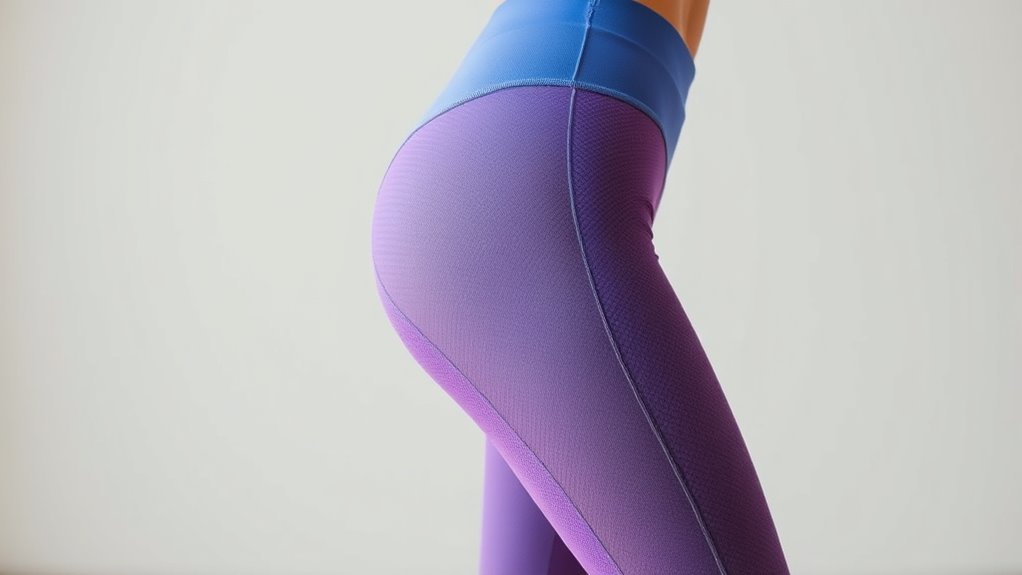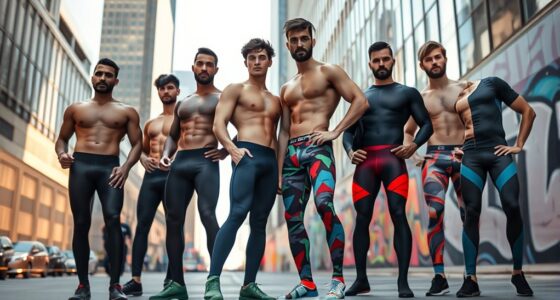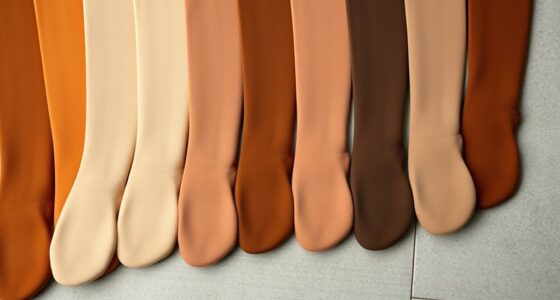Adaptive tights have transformed from basic support garments into stylish, inclusive fashion pieces that prioritize comfort, sustainability, and self-expression. Innovative features like easy fastening systems, breathable and eco-friendly materials, and smart textile technology help you enjoy both function and style. These innovations promote confidence and accessibility, empowering you to participate fully in fashion and social activities. To discover how industry advancements continue to shape this exciting field, continue exploring the cutting-edge developments in accessible hosiery.
Key Takeaways
- Innovative fastening systems like magnetic closures and zippers simplify dressing for individuals with limited dexterity.
- Use of adaptive fabrics with smart textiles enhances comfort and fit through responsive, dynamic adjustments.
- Design features such as mesh panels improve ventilation and accommodate diverse mobility and sensory needs.
- Eco-friendly materials and sustainable manufacturing practices promote inclusivity and environmental responsibility in fashion.
- Industry trends focus on combining style, functionality, and technology to expand accessibility and empower self-expression.
The Evolution of Adaptive Tights: From Functionality to Fashion Statement
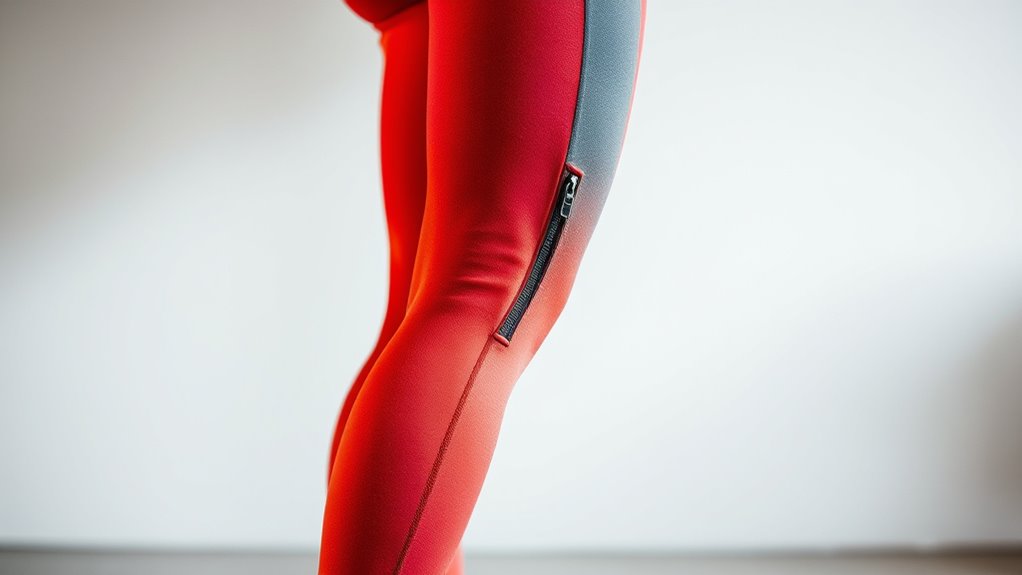
Adaptive tights have come a long way from their original purpose of providing support and ease of use for individuals with mobility challenges. Today, they reflect broader cultural influences and a growing emphasis on sustainability practices. Designers now blend function with fashion, creating pieces that celebrate diversity and inclusivity. Sustainability practices are increasingly integrated, using eco-friendly materials and ethical manufacturing processes to reduce environmental impact. Cultural influences inspire patterns, colors, and styles that resonate with different communities, making adaptive tights more than just functional wear—they’re a statement of identity and empowerment. This evolution demonstrates how adaptive fashion has shifted from purely utilitarian solutions to stylish, socially conscious choices. You can now express yourself confidently while supporting responsible practices in the fashion industry. Additionally, embracing creative practice in design processes can foster innovative approaches to inclusive fashion.
Key Features and Technologies in Modern Adaptive Tights
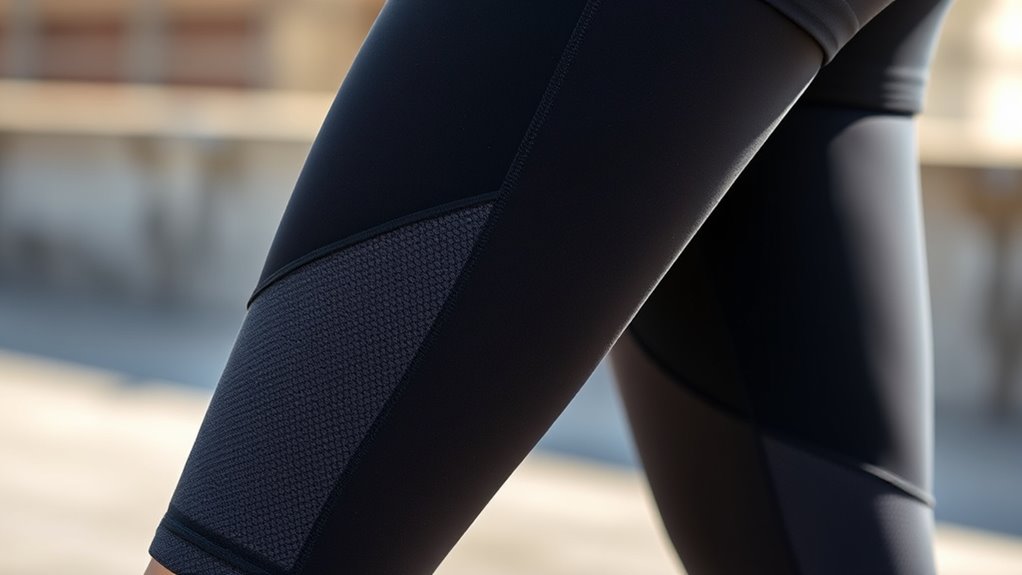
Modern adaptive tights feature easy wear mechanisms that make dressing simpler and more comfortable. Innovative fastening systems guarantee a secure fit without frustration, while adaptive fabric technologies respond to your movement and environment. These key features work together to enhance both accessibility and style in today’s fashion. Embracing artistic expression in design can inspire more inclusive and innovative fashion solutions that cater to diverse needs.
Easy Wear Mechanisms
Easy wear mechanisms in adaptive tights incorporate innovative features and technologies that make dressing and undressing simpler for all users. Magnetic closures are popular because they allow quick, effortless fastening without the need for precise alignment. You can easily secure or release the tights with a gentle pull, reducing strain and frustration. Zip fasteners are another effective option, providing a secure fit while enabling fast removal when needed. These fasteners are designed to be smooth and easy to operate, even with limited dexterity. Combining these mechanisms, modern adaptive tights prioritize convenience and comfort, ensuring you can put on and take off your tights with minimal effort. These features demonstrate how thoughtful design improves accessibility, making fashion more inclusive for everyone. Additionally, incorporating easy-to-use fastening systems enhances overall functionality and user satisfaction.
Innovative Fastening Systems
Innovative fastening systems in adaptive tights leverage advanced technologies to enhance ease of use and security. Magnetic closures and snap fasteners are at the forefront, offering quick, reliable solutions. Magnetic closures allow you to fasten tights effortlessly, even with limited dexterity, providing seamless adjustments. Snap fasteners provide a secure hold that’s easy to open and close, ideal for those needing accessible options. These systems eliminate frustration and promote independence, giving you confidence in every step. Incorporating safety precautions into the design ensures users can enjoy these features without risk.
Adaptive Fabric Technologies
Adaptive fabric technologies in tights incorporate advanced materials that respond to your body’s needs, providing enhanced comfort and functionality. Sensor integration plays a key role, allowing the tights to monitor movement, temperature, and pressure, then adjust stretch or support accordingly. This real-time responsiveness ensures a better fit and reduces discomfort during wear. Many modern adaptive tights also prioritize eco-friendly textiles, using sustainable fibers that are durable and gentle on the environment. These textiles not only support your comfort but also contribute to more sustainable fashion choices. Additionally, the integration of automation technologies in manufacturing processes helps produce these innovative products more efficiently, ensuring consistent quality and accessibility. By combining sensor technology with eco-conscious materials, adaptive tights deliver innovative solutions that improve accessibility and performance, making them an essential part of inclusive fashion. You get to enjoy a product that’s smart, sustainable, and tailored to your needs.
Materials and Designs Promoting Comfort and Durability

You’ll find that innovative stretchable fabrics guarantee your clothing moves with you comfortably. Reinforced seams add durability, so your favorite pieces last longer. Choosing breathable materials keeps you comfortable throughout the day, no matter the activity.
Stretchable Fabric Technologies
Have you ever wondered how stretchable fabrics enhance both comfort and durability in fashion? It all starts with innovative materials like sustainable fibers, which reduce environmental impact while maintaining flexibility. These fibers, such as recycled nylon or Tencel, are designed to stretch without losing shape, providing a comfortable fit for adaptive tights. Advanced dyeing techniques also play a role, allowing vibrant colors to be embedded deeply into the fabric, ensuring longevity and resistance to fading. The combination of these technologies results in tights that move with you, withstand frequent wear, and promote eco-conscious production. By integrating sustainable fibers with thoughtful dyeing methods, manufacturers create stretchable fabrics that meet both durability and comfort needs, making adaptive fashion more accessible and responsible. Additionally, understanding the importance of efficiency ratings helps ensure that the manufacturing processes used are optimized for performance and sustainability.
Reinforced Seams Design
Building on the innovative stretchable fabrics, reinforced seams play a pivotal role in enhancing both comfort and durability in fashion. Seam reinforcement involves using durable stitching techniques that prevent tearing and fraying, especially in areas subject to stress. When you choose tights with reinforced seams, you’ll notice they hold up longer and feel more comfortable against your skin. This design minimizes seam irritation and chafing, ensuring a smooth, secure fit. Durable stitching techniques, such as flatlock or zigzag stitches, strengthen the overall structure without sacrificing flexibility. By paying attention to seam reinforcement, you get apparel that not only lasts longer but also provides consistent support, making your adaptive tights more accessible and reliable for everyday wear.
Breathable Material Choices
Choosing breathable materials is essential for guaranteeing both comfort and longevity in adaptive fashion. When selecting fabrics, prioritize those that enhance moisture control to keep you dry and comfortable throughout the day. Breathable textiles also offer allergen resistance, reducing irritation for sensitive skin. Look for materials that promote airflow, such as lightweight knits or mesh inserts, to prevent overheating. Durable fabrics ensure your tights withstand regular wear without losing shape or function. Consider these options:
- Moisture-wicking fibers that keep sweat away
- Natural fabrics like bamboo or cotton blends
- Synthetic fabrics with allergen-resistant treatments
- Mesh panels for increased ventilation
- Incorporating rustic-inspired textile techniques can add a cozy, farmhouse touch to the design.
How Adaptive Tights Foster Inclusivity and Confidence

Adaptive tights are transforming the fashion landscape by making style more accessible to everyone. They promote style versatility, allowing you to experiment with different looks without feeling limited by traditional designs. When you wear adaptive tights, you feel more confident because they’re designed to fit comfortably and function smoothly, regardless of mobility or sensory needs. This inclusivity fosters a sense of personal empowerment, helping you embrace your individuality and express yourself freely. As a result, adaptive tights not only enhance your wardrobe but also boost your self-esteem. By removing barriers and offering fashionable solutions, they inspire you to participate fully in fashion and social activities, reinforcing the idea that style is for everyone. Headphone compatibility ensures that adaptive fashion can accommodate various devices, making inclusivity even more comprehensive.
Challenges and Opportunities in the Adaptive Fashion Industry
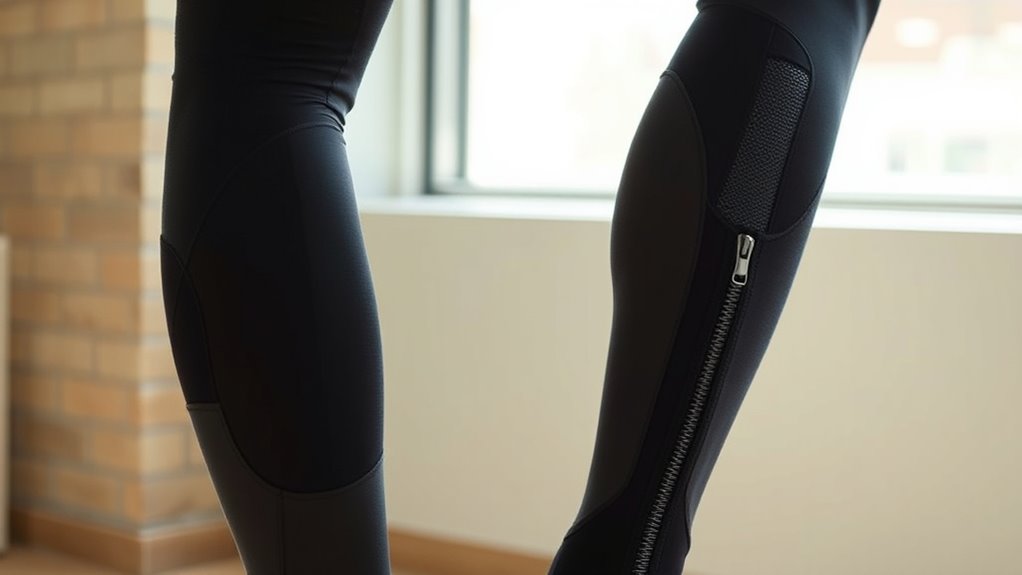
The adaptive fashion industry is gaining momentum as brands recognize the importance of designing clothing that meets diverse needs. However, challenges remain, especially around fashion affordability and industry representation. High production costs can make adaptive clothing pricier, limiting access for many consumers. Additionally, limited industry representation means adaptive fashion often stays on the sidelines, missing diverse voices and ideas. Opportunities exist to change this by:
- Collaborating with designers who understand adaptive needs
- Increasing investment in inclusive product lines
- Raising awareness about adaptive fashion’s importance
- Promoting greater diversity within the industry workforce
- Addressing cost barriers that hinder widespread adoption and accessibility.
Future Trends and Innovations in Accessible Hosiery
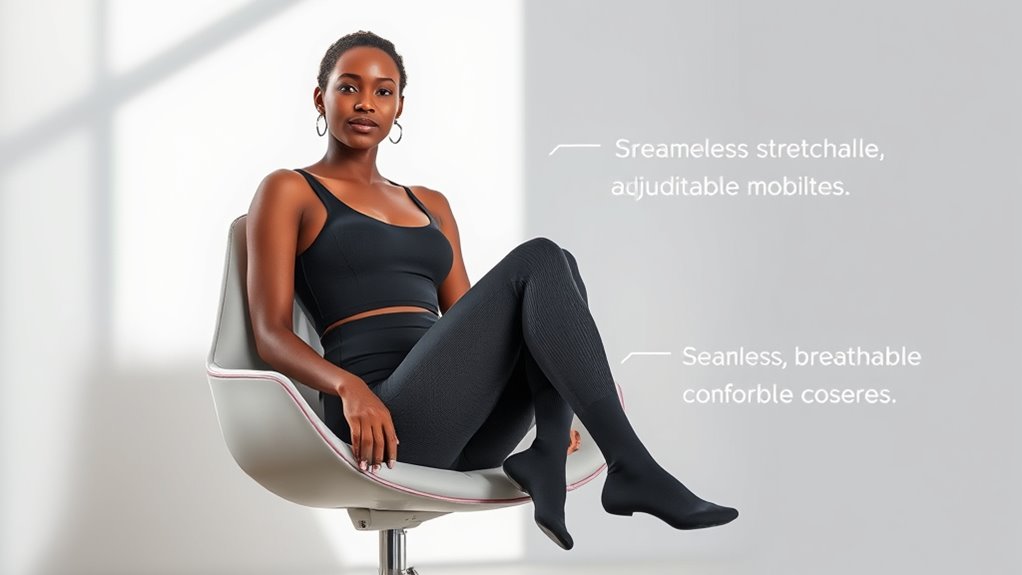
How will emerging technologies shape the future of accessible hosiery? Expect innovations like smart textiles that adapt to your body’s needs, improving comfort and fit. Sustainable sourcing will become a priority, with brands focusing on eco-friendly materials and ethical manufacturing processes. This shift not only benefits the environment but also appeals to conscious consumers seeking socially responsible products. Celebrity endorsements will play a significant role in promoting these advancements, increasing visibility and acceptance of adaptive hosiery. As designers leverage new technologies, you’ll see more stylish, functional options that prioritize accessibility without sacrificing aesthetics. These trends promise a more inclusive future, where accessible hosiery is both innovative and sustainable, making it easier for everyone to feel confident and comfortable. Additionally, industry leaders are recognizing the importance of WWE Raw’s financial impact, which highlights how significant investment in innovative products can transform markets and consumer perceptions.
Frequently Asked Questions
How Do Adaptive Tights Accommodate Different Disabilities Effectively?
Adaptive tights effectively accommodate different disabilities by addressing sensitivity considerations and offering sizing flexibility. You’ll find designs that prioritize comfort, using soft, non-irritating fabrics, and adjustable features to fit various body types. These tights make dressing easier for those with mobility challenges, ensuring a snug but comfortable fit. By focusing on these aspects, adaptive tights promote independence and confidence, creating inclusive fashion options that truly meet diverse needs.
What Are the Environmental Impacts of Materials Used in Adaptive Tights?
Did you know that textile production accounts for nearly 10% of global carbon emissions? When considering adaptive tights, the environmental impacts depend on the materials used. Choosing sustainable fabrics reduces pollution, and eco-friendly dyes lessen water contamination. Your choices matter; opting for eco-conscious options helps protect the planet while supporting innovative, inclusive fashion. By prioritizing these materials, you contribute to a more sustainable and responsible industry.
How Do Adaptive Tights Compare in Cost to Traditional Hosiery?
You’ll find that adaptive tights generally cost more than traditional hosiery due to specialized designs and materials. The pricing comparison shows higher costs driven by added features, but as market demand grows, prices may decrease. You might notice that initial prices are higher, but increased production and sales could make adaptive tights more affordable over time. Ultimately, the investment reflects the value of increased comfort and accessibility for all wearers.
Are Adaptive Tights Suitable for All Skin Types and Sensitivities?
Imagine adaptive tights as a gentle river flowing for all to enjoy. They’re designed with skin sensitivities in mind, often using hypoallergenic materials that minimize irritation. While many are suitable for various skin types, it’s essential to verify specific product labels for allergen info. If you have highly sensitive skin, look for tights explicitly marked hypoallergenicity to guarantee comfort and safety, making your fashion journey inclusive and worry-free.
What Collaborations Exist Between Designers and Disability Advocates?
You’ll find that designer partnerships and advocacy campaigns are increasingly collaborating to promote inclusivity. These alliances focus on creating products, like adaptive tights, that meet diverse needs. You might see brands working directly with disability advocates to guarantee designs are functional and stylish. Such collaborations help raise awareness, influence industry standards, and inspire future innovations, making fashion more accessible and empowering for everyone.
Conclusion
As adaptive tights continue to evolve, the line between function and fashion blurs more than ever. You’ll soon witness innovations that not only enhance comfort and inclusivity but also challenge what you thought was possible. What groundbreaking designs will emerge next? The future of accessible hosiery holds surprising twists, and staying ahead means you won’t want to miss what’s coming. The next chapter in fashion’s inclusive revolution is just around the corner—are you ready to see it unfold?
